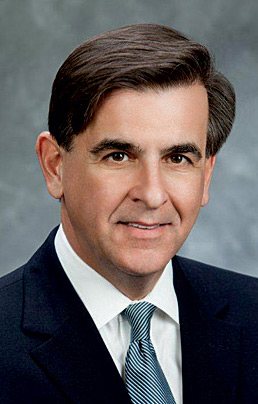 |
About | Scenario | Players | Videos | Recommendations |

|
AboutAbout the Event 201 exerciseEvent 201 was a 3.5-hour pandemic tabletop exercise that simulated a series of dramatic, scenario-based facilitated discussions, confronting difficult, true-to-life dilemmas associated with response to a hypothetical, but scientifically plausible, pandemic. 15 global business, government, and public health leaders were players in the simulation exercise that highlighted unresolved real-world policy and economic issues that could be solved with sufficient political will, financial investment, and attention now and in the future.The exercise consisted of pre-recorded news broadcasts, live “staff” briefings, and moderated discussions on specific topics. These issues were carefully designed in a compelling narrative that educated the participants and the audience. The Johns Hopkins Center for Health Security, World Economic Forum, and Bill & Melinda Gates Foundation jointly propose these recommendations. PurposeIn recent years, the world has seen a growing number of epidemic events, amounting to approximately 200 events annually. These events are increasing, and they are disruptive to health, economies, and society. Managing these events already strains global capacity, even absent a pandemic threat. Experts agree that it is only a matter of time before one of these epidemics becomes global—a pandemic with potentially catastrophic consequences. A severe pandemic, which becomes “Event 201,” would require reliable cooperation among several industries, national governments, and key international institutions.Recent economic studies show that pandemics will be the cause of an average annual economic loss of 0.7% of global GDP—or $570 billion. The players’ responses to the scenario illuminated the need for cooperation among industry, national governments, key international institutions, and civil society, to avoid the catastrophic consequences that could arise from a large-scale pandemic. Similar to the Center’s 3 previous exercises—Clade X, Dark Winter, and Atlantic Storm—Event 201 aimed to educate senior leaders at the highest level of US and international governments and leaders in global industries. It is also a tool to inform members of the policy and preparedness communities and the general public. This is distinct from many other forms of simulation exercises that test protocols or technical policies of a specific organization. Exercises similar to Event 201 are a particularly effective way to help policymakers gain a fuller understanding of the urgent challenges they could face in a dynamic, real-world crisis. When/where
Friday, October 18, 2019 |
 |
 |
 |
PlayersThe following prominent individuals from global business, government, and public health were exercise players tasked with leading the policy response to a fictional outbreak scenario in the Event 201 pandemic tabletop exercise: | ||||
 Latoya Abbott |
 Sofia Borges |
 Brad Connette |
 Christopher Elias |
 Tim Evans |
 George Gao |
 Avril Haines |
 Jane Halton |
 Matt Harrington |
 Martin Knuchel |
 Eduardo Martinez |
 Stephen Redd |
 Hasti Taghi |
 Adrian Thomas |
 Lavan Thiru |
 |
 |
 |
Event 201 VideosStatement about nCoV and our pandemic exerciseIn October 2019, the Johns Hopkins Center for Health Security hosted a pandemic tabletop exercise called Event 201 with partners, the World Economic Forum and the Bill & Melinda Gates Foundation. Recently, the Center for Health Security has received questions about whether that pandemic exercise predicted the current novel coronavirus outbreak in China. To be clear, the Center for Health Security and partners did not make a prediction during our tabletop exercise. For the scenario, we modeled a fictional coronavirus pandemic, but we explicitly stated that it was not a prediction. Instead, the exercise served to highlight preparedness and response challenges that would likely arise in a very severe pandemic. We are not now predicting that the nCoV-2019 outbreak will kill 65 million people. Although our tabletop exercise included a mock novel coronavirus, the inputs we used for modeling the potential impact of that fictional virus are not similar to nCoV-2019. Highlights ReelSelected moments from the October 18th Event 201 Exercise (Length: ~12 minutes)Videos of Event 201These five segments include discussions among high-level leaders of global businesses, governments, policy and public health. (Length ~3 hours)Segment 1 - Intro and Medical Countermeasures (MCM) Discussion Segment 2 - Trade & Travel Discussion Segment 3 - Finance Discussion Segment 4 - Communications Discussion and Epilogue Video Segment 5 - Hotwash and Conclusion |
 |
 |
 |
Public-private cooperation for pandemic preparedness and responseA call to actionThe next severe pandemic will not only cause great illness and loss of life but could also trigger major cascading economic and societal consequences that could contribute greatly to global impact and suffering. Efforts to prevent such consequences or respond to them as they unfold will require unprecedented levels of collaboration between governments, international organizations, and the private sector. There have been important efforts to engage the private sector in epidemic and outbreak preparedness at the national or regional level.1,2 However, there are major unmet global vulnerabilities and international system challenges posed by pandemics that will require new robust forms of public-private cooperation to address.The Event 201 pandemic exercise, conducted on October 18, 2019, vividly demonstrated a number of these important gaps in pandemic preparedness as well as some of the elements of the solutions between the public and private sectors that will be needed to fill them. The Johns Hopkins Center for Health Security, World Economic Forum, and Bill & Melinda Gates Foundation jointly propose the following:
The next severe pandemic will not only cause great illness and loss of life but could also trigger major cascading economic and societal consequences that could contribute greatly to global impact and suffering. The Event 201 pandemic exercise, conducted on October 18, 2019, vividly demonstrated a number of these important gaps in pandemic preparedness as well as some of the elements of the solutions between the public and private sectors that will be needed to fill them. The Johns Hopkins Center for Health Security, World Economic Forum, and Bill & Melinda Gates Foundation jointly propose these recommendations. |
|
1 Global Health Security: Epidemics Readiness Accelerator. World Economic Forum.
https://www.weforum.org/projects/managing-the-risk-and-impact-of-future-epidemics. Accessed 11/19/19 2 Private Sector Roundtable. Global health Security Agenda. https://ghsagenda.org/home/joining-the-ghsa/psrt/. Accessed 11/19/19 3 Peter Sands. Outbreak readiness and business impact: protecting lives and livelihoods across the global economy. World Economic Forum 2019. https://www.weforum.org/whitepapers/outbreak-readiness-and-business-impact-protecting-lives-and-livelihoods-across-the-global-economy. Accessed 12/5/19 |
 |
 |
 |
The Event 201 scenarioEvent 201 simulates an outbreak of a novel zoonotic coronavirus transmitted from bats to pigs to people that eventually becomes efficiently transmissible from person to person, leading to a severe pandemic. The pathogen and the disease it causes are modeled largely on SARS, but it is more transmissible in the community setting by people with mild symptoms.The disease starts in pig farms in Brazil, quietly and slowly at first, but then it starts to spread more rapidly in healthcare settings. When it starts to spread efficiently from person to person in the low-income, densely packed neighborhoods of some of the megacities in South America, the epidemic explodes. It is first exported by air travel to Portugal, the United States, and China and then to many other countries. Although at first some countries are able to control it, it continues to spread and be reintroduced, and eventually no country can maintain control. There is no possibility of a vaccine being available in the first year. There is a fictional antiviral drug that can help the sick but not significantly limit spread of the disease. Since the whole human population is susceptible, during the initial months of the pandemic, the cumulative number of cases increases exponentially, doubling every week. And as the cases and deaths accumulate, the economic and societal consequences become increasingly severe. The scenario ends at the 18-month point, with 65 million deaths. The pandemic is beginning to slow due to the decreasing number of susceptible people. The pandemic will continue at some rate until there is an effective vaccine or until 80-90 % of the global population has been exposed. From that point on, it is likely to be an endemic childhood disease. Risks to Global Businesses from New Era of Epidemics Rival Climate ChangeGeorg Schmitt, Head of Corporate Affairs, World Economic Forum: Tel.: +41 (0)79 571 8287; email: gsch@weforum.org
Geneva, Switzerland, 18 January 2019 – The World Economic Forum, in collaboration with the Harvard Global Health Institute, today released a white paper that details why and how the business community should contribute more to manage the threat and impact of infectious disease on societies. Outbreak Readiness and Business Impact: Protecting Lives and Livelihoods across the Global Economy describes the business risk posed by a new era of epidemic risk, which can no longer be thought of exclusively in terms of rare but devastating events like global influenza pandemics. The white paper offers recommendations to help companies more appropriately understand risks, reduce exposure and act on opportunities for public-private cooperation to optimally prepare for and mitigate these risks. The Forum’s Global Risks Report 2019, released earlier this week, describes a world vulnerable to increasing naturally emerging infectious disease threats and risks posed by revolutionary new biotechnologies. Despite considerable progress, the world remains ill-prepared to detect and respond to outbreaks and is not prepared to respond to a significant pandemic threat. While medical and public health advances allow us to better contain the morbidity and mortality effect of epidemics, our collective vulnerability to the societal and economic impacts of infectious disease crises appears to be increasing. “Outbreaks are a top global economic risk and – like the case for climate change – large companies can no longer afford to stay on the sidelines. Business leaders need to better understand expected costs of epidemics, mitigate these costs and strengthen health security more broadly,” said Vanessa Candeias, Head of the System Initiative on Shaping the Future of Health and Healthcare and Member of Executive Committee at the World Economic Forum. While potentially catastrophic outbreaks may occur only every few decades, highly disruptive regional and local outbreaks are becoming more common and pose a major threat to lives and livelihoods. Recent years have seen nearly 200 epidemic events per year. This trend is only expected to intensify due to increasing trade, travel, population density, human displacement, deforestation and climate change. Further, the number and diversity of epidemic events (e.g. influenza, Ebola, Zika, yellow fever, SARS, MERS-CoV and antibiotic-resistant bacteria, among other threats) have been increasing over the past 30 years. “For individual businesses, developing a better understanding of infectious disease risks and how they can be managed has clear financial benefits. For policy-makers, the better that businesses manage such risks, the more resilient the overall economy will be. Moreover, when business leaders are more aware of what’s at stake, maybe there will be a different dialogue about global health – from being a topic that rarely touches the radar screen of business leaders to being a subject worthy of attention, investment and advocacy,” said Peter Sands, Research Fellow at the Harvard Global Health Institute and Executive-Director of the Global Fund to Fight AIDS, Tuberculosis and Malaria. Although rarely emphasized in businesses’ risk considerations, recent work on pandemics quantifies how massive the potential economic losses from infectious disease outbreaks can be and how they can extend far beyond the original outbreak’s footprint. · Using data from the influenza pandemics of the 20th century, a report by the Commission on a Global Health Risk Framework for the Future estimated the annualized impact of influenza pandemics at roughly $60 billion, more than doubling previous estimates. · Work by Fan, Jamison and Summers that includes statistical value of life years lost revises the annualized figure upward to $570 billion total. For context, this amount is on the same order of magnitude as the $890 billion annual impact of climate change estimated by the Intergovernmental Panel on Climate Change. · Estimates indicate that the 2014-2016 Ebola outbreak in West Africa cost $53 billion, and the 2015 MERS outbreak in South Korea cost $8.5 billion. According to the World Bank, only 39% of the economic losses are associated with effects on infected individuals, with the bulk of the costs resulting from healthy people’s change of behaviour as they seek to avoid infection. While predicting where and when the next outbreak will occur is still an evolving science, it is possible to identify factors that make companies vulnerable to financial losses from infectious disease events. Factors such as the geographic location of a company’s workforce, customer base and supply chain, and the nature and structure of its business, can help inform estimates of its vulnerability to disease outbreaks. One threat is disease and its uncertainty; and another is the fear of disease itself or uninformed panic. As seen in past epidemics, health-related misinformation can spread as fast as viruses to undermine or disrupt the overall medical response efforts. Effective readiness for outbreaks requires reliable, trusted public-private partnership, especially in locations where government capacities are constrained by lack of trust as well as resources. By proactively fostering public-private cooperation at local levels, businesses can help mitigate the potentially devastating human and economic impacts of epidemics, while protecting the interests of their employees and commercial operations. In addition to the report, the research team has produced a prototype corporate infectious disease risk dashboard, meant to enable companies to visualize estimates of expected costs to their business associated with infectious disease outbreaks. At the World Economic Forum Annual Meeting 2019 in Davos next week, the Forum and its partners will advance activities to strengthen public-private cooperation for global health security in areas of vaccines; data science; travel; communications; and supply chain and logistics. View the white paper and prototype corporate infectious disease risk dashboard here. |
 |
 |
 |